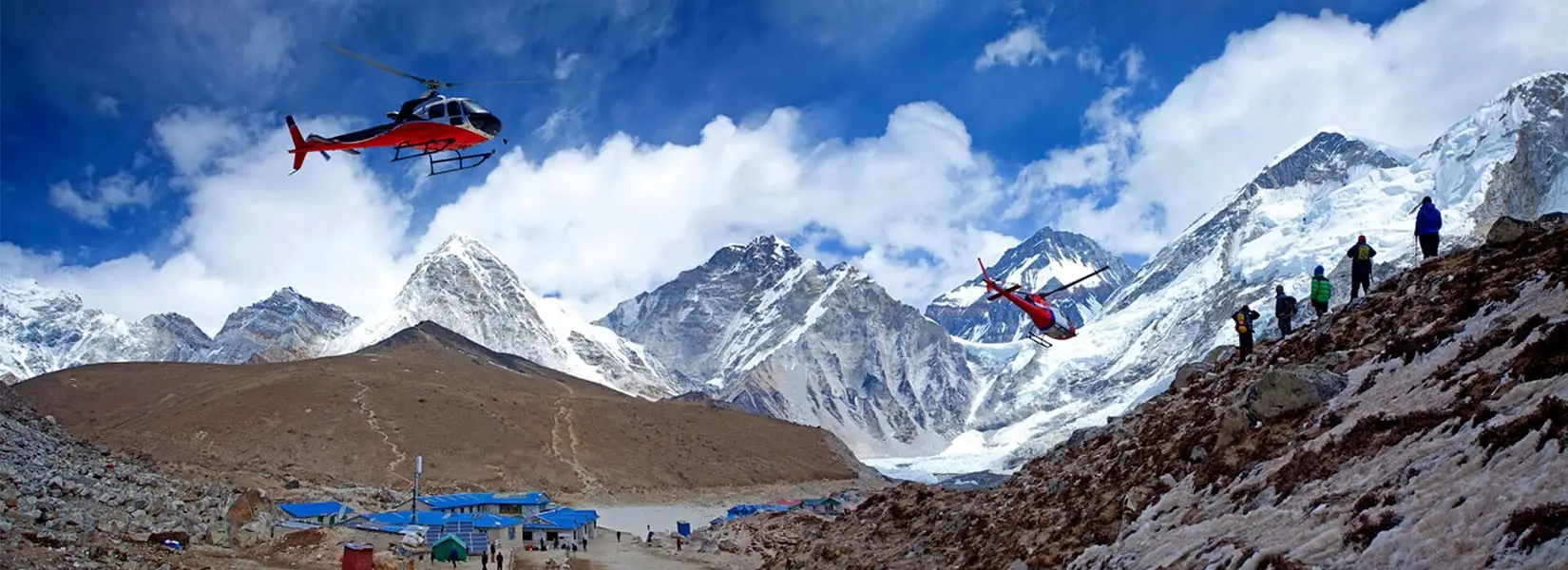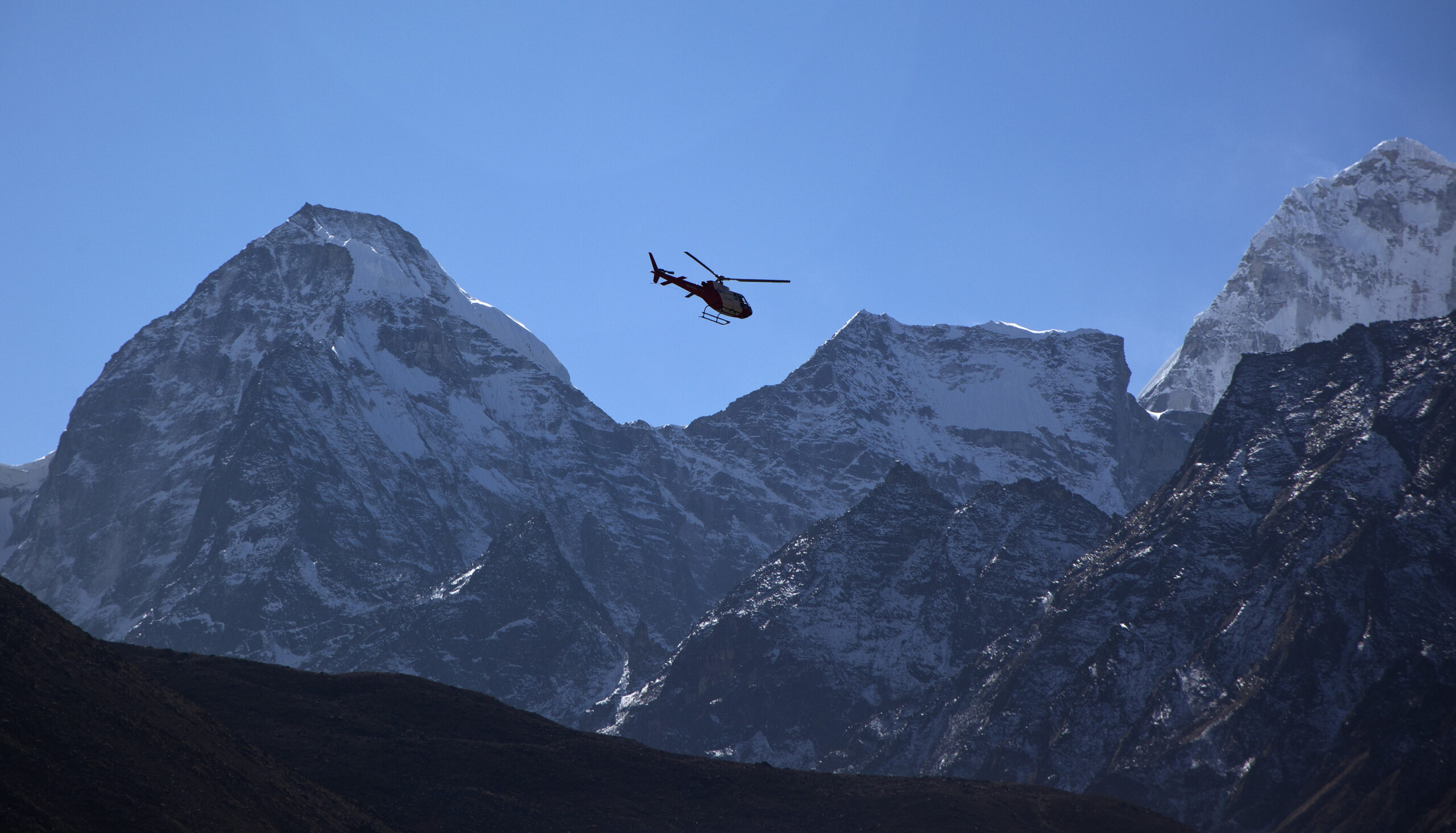14 Days
Moderate
US$1554

Overview of the BanThe towering peaks of the Himalayas, especially Mount Everest, have always drawn adventurers and nature lovers from all over the world. This stunning region has become a favorite spot for trekkers and climbers. In recent years, commercial helicopter flights have become more common, transporting tourists, and supplies, and even helping injured climbers in emergencies. However, as these flights grew in number, so did concerns about their impact on the environment and safety in this fragile area.
In an important step to address these concerns, authorities have announced a ban on commercial helicopter flights in Everest National Park starting December 17.
The Khumbu area’s local trade, economy, and employment have all suffered as a result of the helicopter trip, according to Sushma Rana, senior conservation officer of Sagarmatha National Park. Uncontrolled helicopter landings and flights have created further difficulties for the park’s animals, ecosystem, and forest and habitat conservation.
In addition to the potential for criminal activity, wildlife-related activities, and poaching, helicopter flights have resulted in significant noise pollution in the park’s towns and intermediate areas.
This decision highlights the importance of protecting the delicate environment and ensuring safety in this well-known location. Discussions concerning the move’s effect on tourism have been accompanied by inquiries about how hikers and climbers would adapt to these changes.
Now, wealthy tourists who would want to take a helicopter tour of the Everest region in one or two ways have to think again about how they approach this breathtaking place. On the other hand, the ban is not a major concern for hikers who like traditional hiking.
This restriction acts as a reminder of the delicate balance that needs to be maintained between helping those who wish to witness one of nature’s most magnificent views and preserving this unique site for future generations.
The quickest way to get to enjoy the breathtaking views of the world’s highest mountain Mt. Everest and panoramic view of Everest Region is by helicopter, and commercial helicopters are the greatest choice for people who struggle with hiking because of their physical condition, health problems, altitude sickness, or time limits.
People who lack physical fitness, have other health problems, or don’t have enough time for conventional hiking would be adversely impacted by this new rule.
It will no longer be possible to transport the trekkers/climbing team’s supplies in the helicopter, even during the climbing seasons(spring and fall). Now, visitors will need to hire porters or use the help of Chaunri (mountain mules) above Pangboche, which may add extra days to their itinerary.

Everest Region is not only a popular destination for trekking and mountaineering but also for the symbol of natural wonder. It represents one of humanity’s biggest dreams and is a very popular destination on endless bucket lists.
However, due to increase in the tourism and commercial helicopter activities we have seen some negative impact on the environment of this region. So, for the perseverance of the natural beauty and to minimize the impact, the recent decision to ban commercial helicopter flight in the Sagarmatha National Park and Everest base camp is a good decision.
This iconic destination is home to the towering mountains and endangered species of plants and animals. Local Sherpa people and organisations are doing their best to safeguard this delicate ecosystem. For the sustainable tourism practices and saving the natural beauty of this region for future generations, it is necessary to take every step toward its conservation.
Noise pollution is one of the main factors that led to the decision to ban commercial helicopters. Animals’ communication, mating habits, and predator detection are all hampered by the loud noise made by helicopters. Additionally, it can stress out wildlife, which may force them to alter their behavior or possibly leave their habitats.
Also, for the mountaineers and nature lovers who want to enjoy peaceful time in the mountains, the helicopter sound can be a disturbance. Maintaining an atmosphere of relaxation is essential for a calm experience and for building a strong bond with nature.
Continuous Commercial helicopter flight operation has created a number of risks while landing in the high altitude of Everest region. It can lead to soil erosion, disturbance of vegetation, and potential harm to wildlife.
So to protect the fragile ecosystem of the Sagarmatha National Park this decision of ban of commercial helicopter flight seems to be a practical and effective step. This ban will encourage the development of trekking routes and promote more eco-friendly tourism practices.
This decision is based on a dedication to putting Everest National Park visitors’ welfare first. Helicopter rides can provide a thrilling experience and rapid access to far-flung places, but they also carry safety dangers, especially considering the region’s notoriously harsh weather and altitude-related problems. Abrupt weather changes brought on by altitude can result in dangerous flying situations that put both pilots and passengers in danger.
The ban aims to reduce the likelihood of accidents and ensure that all visitors can enjoy the park’s natural wonders without the added concern of low-flying helicopters and potential emergencies. By discouraging commercial helicopter traffic, park authorities hope to create a safer environment for trekkers and climbers, allowing them to immerse themselves in the awe-inspiring surroundings without distraction.

14 Days
Moderate
US$1554
Even with the ban on the commercial helicopter flights starting from December 17, there will be helicopter flights for some exceptional and special cases.
Emergency Services: As we know that there are no advanced medical services in the high-altitude areas of the Everest Region. So during emergency case like medical emergencies and search operations, still helicopter service will be deployed. These flights will be conducted under the strict rules and regulations under the rules of Nepal government.
Authorized Research and Conservation Missions: Due to the challenging geographical terrain, researchers or conservationists conducting important studies on the environment, wildlife, or climate change may be allowed with a special permit.
Government Officials and Contracted Services: Government officials or contracted services can still use helicopter services for maintaining safety, security, park management and infrastructure development.
Tourism business in the Everest region is one of the main sources of income that contribute towards Nepal’s economy. Shared helicopter services and luxury helicopter services are available from various companies, including Air Dynasty, Prabhu, Kailash, Annapurna, Mountain, Altitude, Fistel, Shree, Cymric, and Heli Everest. But due to the ban this company will no longer provide the service to the customer and it might lead to potential shifts in tourism patterns.
When we check the long- term economic outlook due to more use of local human sources for trekking it adds employment opportunities and helps to boost the local economy.
When we spoke to the locals about the recent ban on commercial helicopter flights to Everest, they expressed positivity and happiness. They believe the ban will lead to the growth of more tea houses and improved facilities, as trekkers will now be staying in these establishments. Additionally, this change will create more job opportunities within their hometowns, benefiting the local community.
Also, the local environmentalists are happy with this decision of commercial ban. They said it will help to preserve the fragile ecosystem by showing the similar ban in some places and their positive effects supported by data.
When we talked with a Trekking Guides in our team, they were pretty happy with the ban. They have experienced many of their clients doing Everest Base Camp Trek being mad at them when they had to trek under the huge noise of helicopters all day long. Trekkers said to them many times that they were there to enjoy the beauty of the majestic Himalayas in a peaceful environment. With the helicopter’s noise, it was pretty insane! Now they can guide their clients in a peaceful denouement with the sounds of birds, animals, winds, the roar of the rivers, and glaciers.
When we asked the Helicopter business owners, operators, and hotel owners about the ban on commercial helicopters, they were not happy with this decision. This is because helicopter services are key to their business. They added that before this decision on the ban, everyone was welcome to see the beauty of the world’s highest mountain, even if they were physically unable. But now, only those who are in great physical condition and can do the traditional trekking can enjoy the beauty of Everest.

Now after the ban trekkers and the mountaineers need to rely on porters or chaunrie to carry their gear and equipment. This change has brought attention to the need for effective mobility options in these wilderness areas, where access is frequently restricted.
Due to the ban on commercial helicopter service, all guests who wish to explore the majestic Everst must now trek traditionally. Let’s examine the benefits and drawbacks of conventional trekking:
We can see similar bans in places like Machu Picchu airspace for commercial helicopters for the protection of indigenous wildlife. Also, many other regions which are famous for their natural beauty and cultural heritage are starting to ban commercial helicopter flights. It will help to protect their ecosystem and maintain the integrity of their landscape.
Establishing clear and strict regulations from the government as well as the local bodies will help in the management of helicopter bans in sensitive areas.
Several agencies like the Nepal Tourism Board, Department of Sagarmatha National Park and Wildlife Conservation, local government officials, indigenous communities, and conservation organizations will now regulate the ban of commercial helicopters in the Everest region.
The Civil Aviation Authority of Nepal will now allow the helicopter to fly only for the rescue operation for the visitors. Nepal Army will also do the regular inspection of the helicopter flight in the Everest.
Nepal offers countless trekking and mountaineering destinations. Visitors who wish to experience the beauty of towering mountains can still explore other famous places as alternatives to Everest, such as:
Those who wish to trek in the Sagarmatha National Park and mountaineering in the Everest here are some of the important practical tips from the Expert:
There are numerous trekking agencies in Nepal that do the trekking business in Nepal including the Everest Region. You can choose the best trekking agency by searching through social media or directly visiting their website. While choosing the trekking agency make sure that they are registered under the Trekking Agencies Association of Nepal (TAAN). Trekking agencies will provide you great service like providing guide, porter, arranging transportation, providing accommodation and food during the trek.
After the solo travel ban in Nepal you cannot do the solo trek in Nepal inside the National Park and sensitive areas like wildlife conservation. So make sure to hire an expert guide that will help to meet your expectations. Also now after the ban of helicopters in the Everest Region we suggest you hire the local Sherpa guide and porter who knows well about this region and has previous experience.
If you want to enjoy the wilderness of the Everest Region it is necessary to have physical fitness along with mental fitness. Trekking everyday for more than a week in the Everest Region in the difficult terrain is definitely not an easy task. So before you plan to visit for trekking work to maintain your physical fitness.
Trekking in the higher elevation of the Everest Region is a risky job. You will never know when things will go wrong therefore we suggest you purchase the travel insurance that covers the medical emergency for the trek, helicopter evacuation, theft and loss of the luggage, flight delays, changes in the itinerary due to weather conditions etc.
You may have seen the social media video of Everest traffic that went viral. Trekking and climbing Everest are famous international craze. During the peak season the accommodation inside the tea house is packed so for your ease and convenience we suggest you book the trek in advance.

Starting from December 17 now all the helicopter transitional will transfer to the traditional trekking due to ban in Commercial helicopter service in Everest Region. If you are planning for the helicopter service now you need to change your plan to traditional trekking.
Addressing concerns over environmental impact and safety of Everest Region we suggest you to trek only with the registered trekking agency. Make sure that you prepare in advance before booking the trip and maintain physical fitness to have a better experience.
Helicopter ban on the sensitive areas of Everest is another big step toward the perseverance of the natural beauty and the practice of sustainable tourism. By utilizing traditional trekking methods we suggest our visitor to follow the safety guidelines and a responsible adventure.
Trekking through the traditional method offers numerous benefits, including improved physical fitness, a deeper appreciation for the beauty of nature, and opportunities to learn about Sherpa culture and lifestyle.
Let us know how we can make your Everest Dream into a Reality!